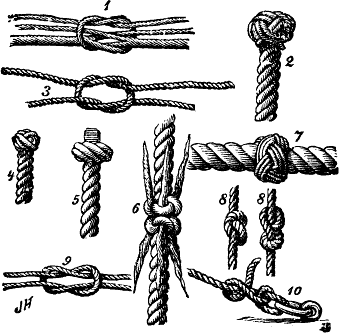10 knots to help you over summer!

With summer underway, we thought it would be helpful to share 10 great knots that can be used on and off the boat! Not only will you find these knots helping you out with daily hacks, they are important to know when it comes to boat safety. Knots are used to not only secure the boat to the dock but to secure all items on the decks.
The Half Hitch Knot
Half hitch knots secure lines to a post or pole. Often two half hitches are used, creating a reliable hitch and helping sailors remember that a half hitch is actually only half of the knot.
The Bowline Knot
The mighty bowline is known as the “King of Knots.” It is the most commonly used knot in boating. The bowline creates a loop at the end of the line that cannot shrink or expand. Because it tightens when stressed, the more the line gets pulled, the tighter the knot becomes.
The Clove Hitch Knot
The clove hitch is commonly used to secure boats to docks that have a rail rather than cleats. The line wraps around itself without a real knot, making for a quick release when shoving off.
The Square Knot
The square knot ties two lines together. It can be used to create longer lines, tie the boat to another line, or combine lines for some other function. Frequently used for reefing or furling sails, the square is another knot that tightens with stress, and is extremely reliable.
The Figure Eight Knot
Also known as a Flemish knot, the figure eight creates a stopper at the end of a line. Its name says it all — in the shape of the figure eight, the knot, when tightened, provides a secure endpoint to any line. Figure eights are often used to ensure that a line does not run out of a pulley or other tackle on board.
The Sheet Bend Knot
The sheet bend knot joins together two lines of different sizes or materials. The larger line is the bight (the curved, slack portion), and the smaller line loops through it. The sheet bend can also be used for lines of equal size, and is preferred to a square knot by some because it is less likely to jam and become difficult to untie.
The Anchor Bend Knot
One thing you almost never want to become untied is your anchor. The self-explanatory anchor bend assures this. It consists of two half hitches plus two wraps around the object. It tightens fiercely when under load, and usually has to be cut off rather than untied (if that ever becomes necessary).
The Rolling Hitch Knot
The rolling hitch ties an additional line to an existing one, acting as another leg. The new line is tied in the middle of an existing, taut one. When rafting boats together, a line is often used as a kind of provisional dock rail, and the rolling hitch is used to secure the boat to the rail or line.
The Trucker’s Hitch Knot
While you might not think this is a boating knot, it is. The trucker’s hitch is used to secure loads on deck (or on a truck, hence the name). An example is tying a dingy down while underway. The standing end is tied with a bowline; the line is lashed over the object, tightened with a trucker’s hitch, and finished with a half hitch and finally a quick-release half hitch.
The Slip Hitch Knot
A slip hitch is a knot that will slide (or slip) along the line to tighten or loosen as needed. It is one of the easiest lines to tie and untie. This is a common knot used to attach fenders to rails. Because it is easily untied, it is not commonly used to secure things for long periods of time or when the line is likely to be under severe stress.
Learn these ten knots and you will be sorted for the rest of your boating life. Use them frequently and you will impress your fellow boaters with your knotting skills!
